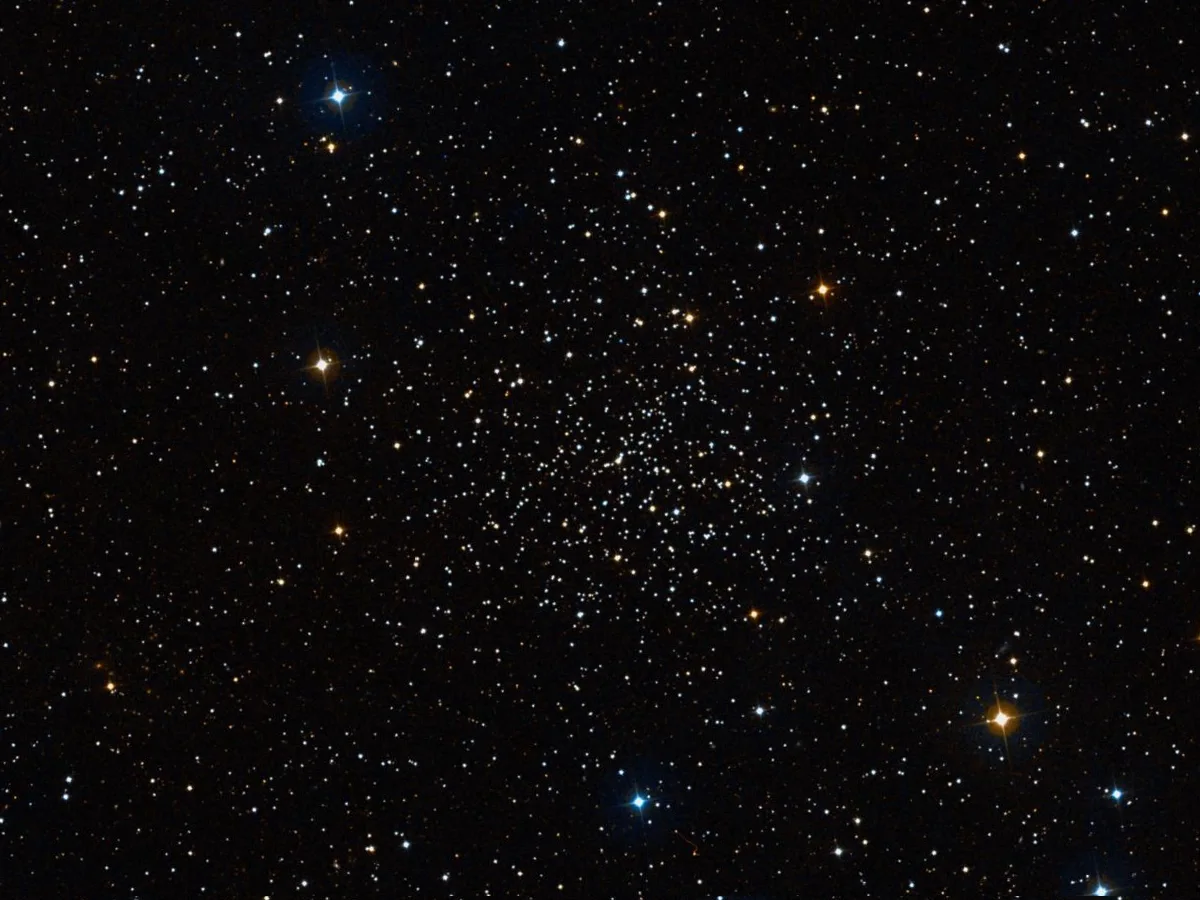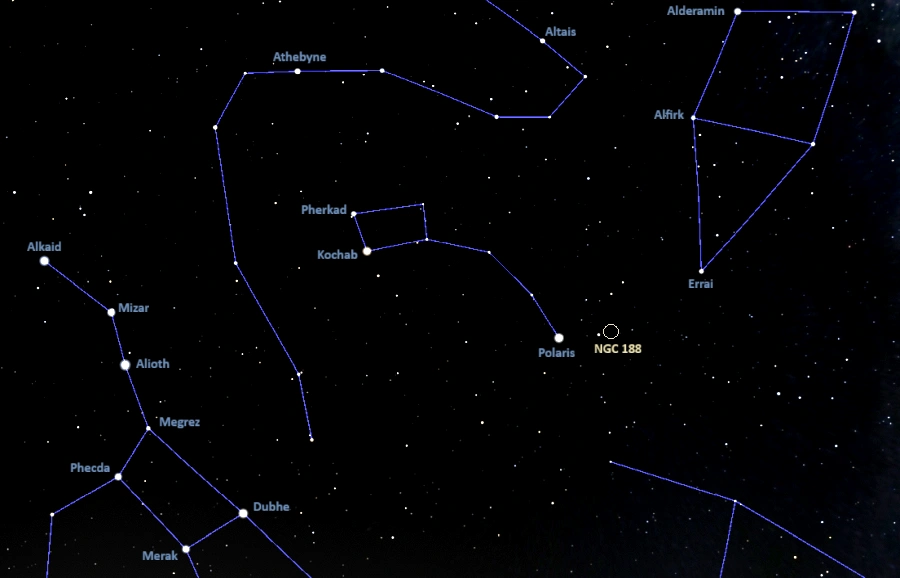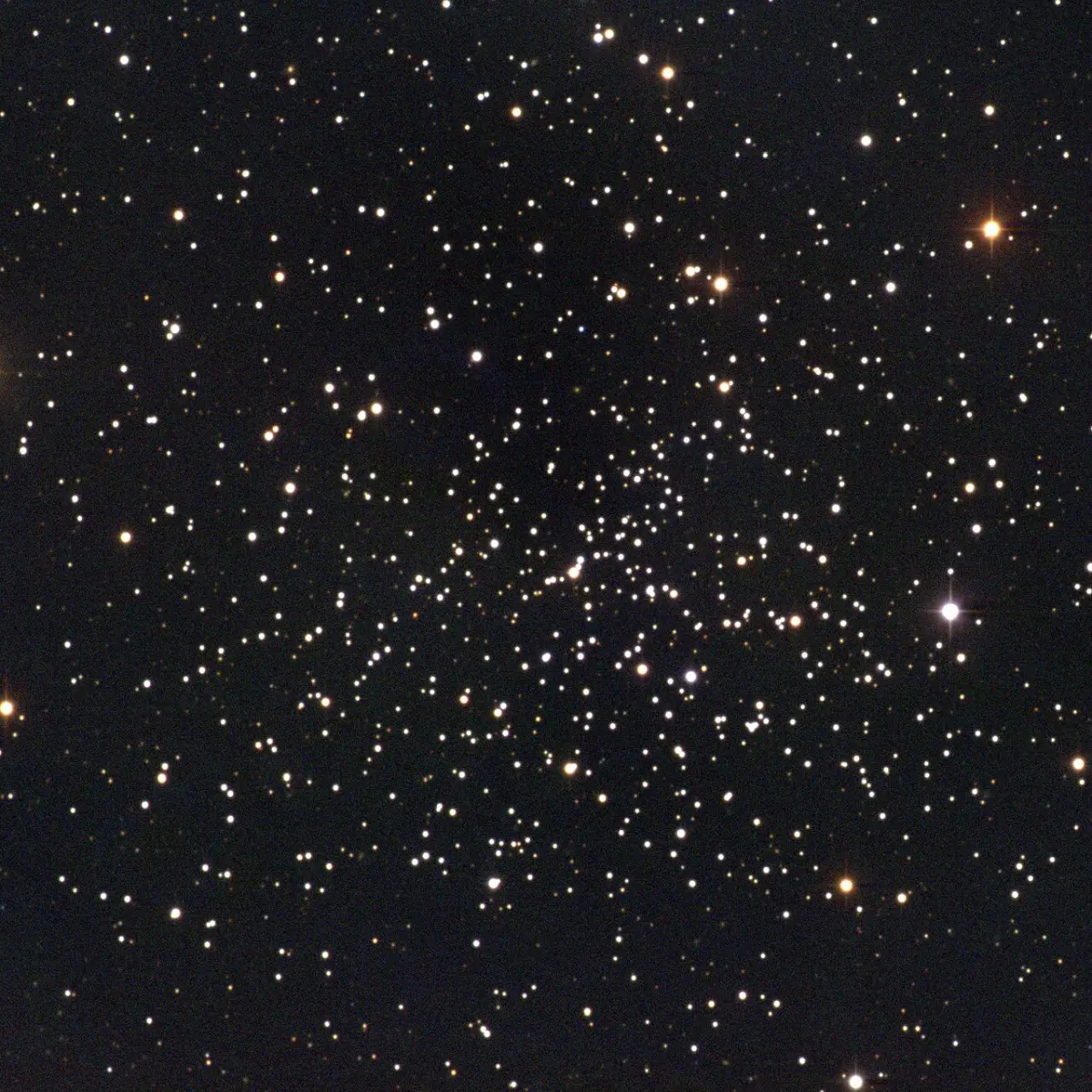The Polarissima Cluster is an open star cluster located approximately 6,000 light-years away in the constellation Cepheus. The cluster lies less than 5 degrees from the north celestial pole. With an apparent magnitude of 10.0 and an apparent size of 15 arcminutes, it can be spotted in a small telescope. It is catalogued as NGC 188 in the New General Catalogue and Caldwell 1 (C1) in the Caldwell catalogue.
NGC 188 lies slightly above the Milky Way’s disk, far above the galactic plane. With an estimated age of 6.41 billion years, it is one of the oldest open clusters known in our galaxy. The stars in the cluster formed in the same molecular cloud at around the same time and are still moving together through space.
Most open clusters disperse within the first 100 million years. The Polarissima Cluster was able to survive for billions of years because it lies above the Milky Way’s plane, where it has had little interaction with other stars.

Polarissima Cluster (NGC 188), image credit: ESO/Digitized Sky Survey 2 (CC BY 4.0)
The cluster lies between 8 and 9 kiloparsecs (26,093 – 29,354 light-years) from the Milky Way’s centre, more than 500 parsecs (1,621 ly) above the galactic plane, which is how it evaded being affected by the densely populated galactic disk. It has, however, lost a significant number of members at its periphery. The remaining stars are those that initially formed the cluster’s core. Astronomers believe that NGC 188 has lost more than 70 percent of its initial mass.
The age of 6.41 Gyr and distance of 6 kilolight-years were derived in a 2025 study based on the radial velocities and spectral energy distributions of several binary stars in the cluster. A team of astronomers, led by Kadri Yakut of the Department of Astronomy and Space Sciences at Ege University in Turkey, identified a total of 1,175 candidate members of the cluster.
The Polarissima Cluster contains blue stragglers, stars that appear younger, bluer and more luminous than other nearby cluster members. Astronomers believe that these stars form in collisions and interactions with their neighbours. Blue stragglers have a higher mass and are typically found at the cores of star clusters, especially old globular clusters, which are more densely packed than the outskirts.
The Polarissima Cluster was discovered by the English astronomer John Herschel on November 3, 1831. Herschel spotted the cluster in his 18.3-inch reflector and listed it as h 34 in his catalogue of 1833. In 1864, he included the cluster in his General Catalogue as GC 92.
Based on Herschel’s observations, the Danish astronomer John Louis Emil Dreyer listed the cluster as NGC 188 in his New General Catalogue of 1888.

This collection of stars is part of Caldwell 1, the first object in the Caldwell catalog. Also known as NGC 188, it is an open cluster, a group of stars that were all formed from the same large cloud of gas and are therefore all roughly the same age. Scientists are interested in such clusters because they can study how the chemicals in each star vary from one star to another. Many open clusters, like Caldwell 1, are made up of stars that aren’t very close together and therefore have only a loose gravitational connection. For this reason, these stars have the tendency to slowly drift apart over millions of years. But Caldwell 1 is different. One of the oldest open clusters known, it sits far enough away from our galaxy’s core that it hasn’t yet been ripped apart by the galaxy’s gravitational influences. Caldwell 1 is estimated to be at least 6.8 billion years old. Caldwell 1 was discovered in 1831 by John Herschel, an English polymath who invented the blueprint and named seven of Saturn’s moons along with four moons orbiting Uranus, the planet his father, William Herschel, discovered. This ancient cluster, which boasts an apparent magnitude of 8.1, contains a good number of middle-aged stars called main sequence stars. Such stars often pique the interest of researchers because they tend to be the best candidates to host exoplanets that could support life. However, Caldwell 1 is over 5,400 light-years away from Earth, making it slightly more difficult to study than closer stars when searching for planets. The image above, showing just a portion of Caldwell 1, was captured by Hubble’s Wide Field Camera 3. Credit: NASA, ESA and L. Dressel (STScI); Processing: Gladys Kober (NASA/Catholic University of America) (CC BY 2.0)
Location
The Polarissima Cluster lies near the northern celestial pole, in the region between Polaris in Ursa Minor and Errai in Cepheus. Polaris, the nearest bright star to the cluster, can be found by extending a line from Merak through Dubhe, the stars that form the outer part of the Big Dipper’s bowl. The North Star marks the end of the Little Dipper’s handle and the Little Bear’s tail. Shining at magnitude 1.98, it easily stands out in the otherwise dim region of the sky around the pole.
At declination +85°, the cluster is circumpolar in the northern hemisphere and cannot be seen from the southern hemisphere. Like all objects listed in the Caldwell catalogue, it can be observed in backyard telescopes.
The best time of the year to observe NGC 188 and other deep sky objects in Cepheus is during the month of November, when the constellation appears higher above the horizon around 9 pm. Due to its location near Polaris, the Polarissima Cluster always appears in more or less the same place in the sky, within 5 degrees of the pole.

NGC 188 location, image: Stellarium
Polarissima Cluster – NGC 188
| Constellation | Cepheus |
| Object type | Open cluster |
| Right ascension | 00h 47m 14.8s |
| Declination | +85° 14′ 42″ |
| Apparent magnitude | 10.0 |
| Apparent size | 15′ |
| Distance | 6,000 light-years (1,850 parsecs) |
| Radius | 11.8 light-years |
| Age | 6.41 ± 0.33 billion years |
| Names and designations | Polarissima Cluster, NGC 188, Caldwell 1, C1, Collinder 6, Cr 6, Melotte 2, Mel 2, MWSC 0074, C 0039+850, OCl 309.0 |
Images

Caldwell 1 (NGC 188) in Cepheus. Photographed using a Meade LX200 SCT (200 mm). Image credit: Wikimedia Commons/DexterMobot (CC BY-SA 4.0)

NGC188 is an open star cluster in the constellation Cepheus. With a membership of around 120, it may be the oldest known open cluster, although age estimates have varied from as much as 24 billion years (which some may notice is a bit of an anomaly when compared to the current estimates of the age of the Universe), to as `little’ as only five billion years. NGC188 was first noticed by John Herschel before 1833. NGC188’s most recent claim to fame is as item number 1 in Patrick Moore’s Caldwell list of challenging objects for observers bored with the Messier catalogue. This image was taken with the WIYN 0.9-meter telescope at the Kitt Peak National Observatory on the night of December 19th 2002 UT. Image size 21.5 arc minutes. Credit: NOIRLab/NSF/AURA (CC BY 4.0)